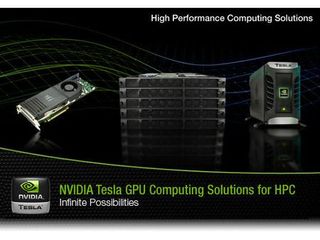Nvidia's CUDA: The End of the CPU?
Conclusion, Continued
So what does CUDA need in order to become the API to reckon with? In a word: portability. We know that the future of IT is in parallel computing – everybody’s preparing for the change and all initiatives, both software and hardware, are taking that direction. Currently, in terms of development paradigms, we’re still in prehistory – creating threads by hand and making sure to carefully plan access to shared resources is still manageable today when the number of processor cores can be counted on the fingers of one hand; but in a few years, when processors will number in the hundreds, that won’t be a possibility. With CUDA, Nvidia is proposing a first step in solving this problem – but the solution is obviously reserved only for their own GPUs, and not even all of them. Only the GF8 and 9 (and their Quadro/Tesla derivatives) are currently able to run CUDA programs.


Nvidia may boast that it has sold 70 million CUDA-compatible GPUs worldwide, but that’s still not enough for it to impose itself as the de facto standard. All the more so since their competitors aren’t standing by idly. AMD is offering its own SDK (Stream Computing) and Intel has also announced a solution (Ct), though it’s not available yet. So the war is on and there won’t be room for three competitors, unless another player – say Microsoft – were to step in and pick up all the marbles with a common API, which would certainly be welcomed by developers.

So Nvidia still has a lot of challenges to meet to make CUDA stick, since while technologically it’s undeniably a success, the task now is to convince developers that it’s a credible platform – and that doesn’t look like it’ll be easy. However, judging by the many recent announcements in the news about the API, the future doesn’t look unpromising.
See our review of Nvidia’s GT200 GPUs for more on CUDA.
For the latest on CUDA click here.
Stay on the Cutting Edge
Join the experts who read Tom's Hardware for the inside track on enthusiast PC tech news — and have for over 25 years. We'll send breaking news and in-depth reviews of CPUs, GPUs, AI, maker hardware and more straight to your inbox.
-
CUDA software enables GPUs to do tasks normally reserved for CPUs. We look at how it works and its real and potential performance advantages.Reply
Nvidia's CUDA: The End of the CPU? : Read more -
Well if the technology was used just to play games yes, it would be crap tech, spending billions just so we can play quake doesnt make much sense ;)Reply
-
dariushro The Best thing that could happen is for M$ to release an API similar to DirextX for developers. That way both ATI and NVidia can support the API.Reply -
dmuir And no mention of OpenCL? I guess there's not a lot of details about it yet, but I find it surprising that you look to M$ for a unified API (who have no plans to do so that we know of), when Apple has already announced that they'll be releasing one next year. (unless I've totally misunderstood things...)Reply -
neodude007 Im not gonna bother reading this article, I just thought the title was funny seeing as how Nvidia claims CUDA in NO way replaces the CPU and that is simply not their goal.Reply -
LazyGarfield I´d like it better if DirectX wouldnt be used.Reply
Anyways, NV wants to sell cuda, so why would they change to DX ,-) -
I think the best way to go for MS is announce to support OpenCL like Apple. That way it will make things a lot easier for the developers and it makes MS look good to support the oen standard.Reply
-
Shadow703793 Mr RobotoVery interesting. I'm anxiously awaiting the RapiHD video encoder. Everyone knows how long it takes to encode a standard definition video, let alone an HD or multiple HD videos. If a 10x speedup can materialize from the CUDA API, lets just say it's more than welcome.I understand from the launch if the GTX280 and GTX260 that Nvidia has a broader outlook for the use of these GPU's. However I don't buy it fully especially when they cost so much to manufacture and use so much power. The GTX http://en.wikipedia.org/wiki/Gore-Tex 280 has been reported as using upwards of 300w. That doesn't translate to that much money in electrical bills over a span of a year but never the less it's still moving backwards. Also don't expect the GTX series to come down in price anytime soon. The 8800GTX and it's 384 Bit bus is a prime example of how much these devices cost to make. Unless CUDA becomes standardized it's just another niche product fighting against other niche products from ATI and Intel.On the other hand though, I was reading on Anand Tech that Nvidia is sticking 4 of these cards (each with 4GB RAM) in a 1U formfactor using CUDA to create ultra cheap Super Computers. For the scientific community this may be just what they're looking for. Maybe I was misled into believing that these cards were for gaming and anything else would be an added benefit. With the price and power consumption this makes much more sense now. Agreed. Also I predict in a few years we will have a Linux distro that will run mostly on a GPU.Reply
Most Popular

